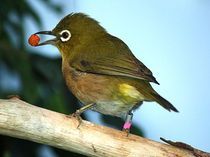Chinese white-eye
The Japanese White-eye is about 4 to 4.5 inches in size, with a green forehead and a yellow throat, a greenish back, and dark brown wings and tail outlined in green. Like other white-eyes, this species exhibits the distinctive white eyering that gives it its name . It is omnivorous, feeding primarily on insects and nectar. When building nests, they often steal material from the nests of other birds.
The Chinese white-eye is classified as Least Concern. Does not qualify for a more at risk category. Widespread and abundant taxa are included in this category.
* Painting Chinese White-Eye in watercolours * Today I finished a cockatoo in watercolours. More
divaricatus) and Chinese white-eye (Zosterops erythropleurus) nest in low-lying broadleaf forests. The brightly-colored Eastern broad-billed roller (Eurystomus orientalis) is found mainly in floodplain forests, where it nests in tree dens. Common cross-bill (Loxia curvirostra), Siberian jay (Perisoreus infaustus), and Northern three-toed woodpecker (Picoides tridactylus) are common residents of mixed spruce and fir forests, whereas spotted-nutcrackers (Nucifraga caryocatactes) prefer Siberian pine forests. White-throated rock thrush (Monticola gularis) thrive in sub alpine pine groves, venturing to higher elevations than other forest-dwelling birds. More

Original source: Ltshears
Author: Ltshears
Permission: Some rights reserved
Family : Zosteropidae
Genus : Zosterops
Species : japonicus
Authority : Temminck & Schlegel, 1847

